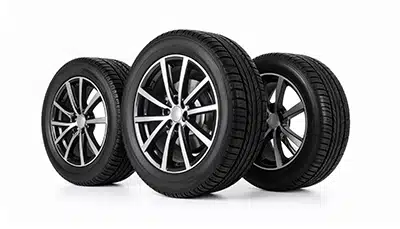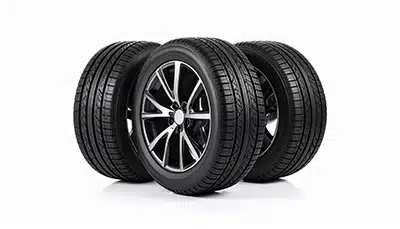Understanding Performance Tire Technology
Performance tires represent the cutting edge of tire engineering, where advanced compounds, specialized tread patterns, and precision construction combine to deliver extraordinary grip and handling capabilities. At Custom Wheels N Tires, we understand that selecting the right performance tire can transform your driving experience, enhancing everything from cornering confidence to braking effectiveness.
Whether you're looking to maximize your sports car's capabilities, improve your daily driver's responsiveness, or prepare for occasional track days, today's performance tire market offers specialized options to match your specific needs. Let's explore the essential aspects of performance tires to help you make an informed decision.
Performance Tire Categories
Ultra High Performance (UHP) Tires
Ultra High Performance tires represent the premium segment of street-legal performance rubber, designed for drivers who demand exceptional handling without sacrificing reasonable tread life and all-season capability.
Key characteristics of quality UHP tires include:
- Specialized rubber compounds optimized for grip without excessive wear
- Asymmetric or directional tread patterns enhancing cornering stability
- Reinforced sidewalls for precise steering response
- Speed ratings of W (168+ mph) or Y (186+ mph)
- Enhanced wet performance compared to extreme performance options
UHP tires strike an excellent balance for enthusiasts who use their vehicles daily but still appreciate spirited driving on winding roads or occasional autocross events. Popular models include the Michelin Pilot Sport 4S, Continental ExtremeContact Sport, and Bridgestone Potenza Sport.
Max Performance Summer Tires
Max Performance tires prioritize dry grip and handling precision above all else, making them ideal for sports cars and performance vehicles driven primarily in warm weather conditions.
Distinguishing features include:
- Specialized summer compounds that deliver exceptional dry traction
- Minimal tread void areas maximizing rubber-to-road contact
- Advanced construction focusing on feedback and responsiveness
- Superior high-temperature stability for sustained performance
- Shorter tread life compared to UHP tires (typically 15,000-25,000 miles)
These tires excel during warm months and spirited driving, though they require switching to all-season or winter tires when temperatures drop below approximately 45°F (7°C). Top contenders include the Yokohama ADVAN Neova AD08R, Dunlop Direzza ZIII, and Falken Azenis RT660.
Extreme Performance/Track Tires
For drivers who regularly participate in track days or competitive motorsports, extreme performance tires (sometimes called "R-compound" or "DOT competition" tires) deliver race-car-like grip while maintaining street legality.
Notable characteristics include:
- Specialized racing-derived compounds for maximum adhesion
- Minimal tread patterns focused on dry performance
- Heat cycle sensitivity requiring proper warm-up
- Significantly reduced tread life (often under 10,000 miles)
- Minimal to no wet-weather capability
These specialized tires are best reserved for dedicated enthusiasts who understand their limitations and maintenance requirements. Leading options include the Michelin Pilot Sport Cup 2, Goodyear Eagle F1 SuperCar 3R, and Pirelli P Zero Trofeo R.

All-Season Performance Tires
For drivers in variable climates or those seeking a single-tire solution, all-season performance tires offer enhanced grip and handling compared to standard touring tires while maintaining year-round usability.
Benefits include:
- Balanced performance across temperature ranges and conditions
- Longer tread life than dedicated summer performance tires
- Improved wet and light snow traction
- More comfortable ride quality and reduced road noise
- Cost-effective alternative to seasonal tire changes
While they don't match the maximum capabilities of specialized summer performance tires, modern all-season performance options like the Continental ExtremeContact DWS06 Plus, Michelin Pilot Sport All Season 4, and Bridgestone Potenza RE980AS deliver impressive versatility for enthusiasts in changeable climates.
Critical Performance Tire Technologies
Compound Innovations
The rubber compound forms the foundation of a performance tire's capabilities, with manufacturers constantly developing new formulations to push the boundaries of grip and durability:
- Multi-compound technology: Different rubber compounds across the tread face optimize cornering grip while maintaining center tread durability
- Silica-enhanced compounds: Improve wet grip without sacrificing dry performance or increasing rolling resistance
- Temperature-adaptive polymers: Maintain consistent performance across a wider temperature range
- Nano-composite materials: Molecular-level engineering creating more uniform wear and consistent performance throughout the tire's life
These compound technologies represent the most significant area of performance advancement in recent years, enabling today's tires to deliver grip levels that would have been considered impossible a decade ago.
Tread Design Considerations
Performance tire tread patterns are carefully engineered to maximize grip while managing heat, water evacuation, and noise:
- Asymmetric patterns: Different tread designs on inner and outer portions optimize both straight-line stability and cornering grip
- Directional designs: V-shaped patterns that efficiently channel water while providing excellent straight-line stability
- Variable pitch sequencing: Reduces road noise without compromising performance characteristics
- Specialized siping: Micro-slits that enhance wet grip while maintaining tread block stability
The ideal tread design varies based on your driving priorities, with some patterns favoring absolute dry grip while others offer better all-weather versatility.
Construction Elements
Internal tire construction plays a crucial role in performance, with several key elements determining how a tire responds:
- Sidewall construction: Stiffer sidewalls improve steering response but may reduce comfort
- Cap ply systems: Additional reinforcement layers that maintain tire shape at high speeds
- Bead design: Affects how precisely the tire mounts to the wheel and transfers steering inputs
- Internal reinforcement: Specialized materials like Aramid fibers increase stability while minimizing weight
These construction differences explain why tires with similar appearances can deliver dramatically different driving experiences—the magic happens beneath the visible tread surface.
Selecting the Right Performance Tire
Performance vs. Longevity
When selecting performance tires, it's essential to understand the inevitable trade-offs between maximum grip and tread life. Generally, softer compounds that deliver exceptional traction will wear more quickly than harder, more durable formulations. Consider your priorities:
- Maximum performance enthusiasts may accept 15,000-20,000 mile tread life
- Balanced performance typically delivers 25,000-40,000 miles
- Performance all-season options can reach 40,000-60,000 miles
Our tire experts can help you find the sweet spot that matches your driving style and replacement budget.

Sizing Considerations
Performance tire sizing affects both appearance and handling characteristics:
- Plus-sizing: Moving to larger diameter wheels with lower-profile tires can improve responsiveness
- Width selection: Wider tires increase dry grip but may increase hydroplaning risk
- Aspect ratio: Lower profile tires (smaller sidewall percentage) enhance steering precision but reduce comfort
- Staggered setups: Different sizes front/rear can enhance handling balance on rear-wheel drive vehicles
Always ensure your tire selection maintains proper load-carrying capacity and compatible speed rating for your vehicle and driving needs.
Key Takeaways: Performance Tires
- Ultra High Performance (UHP) tires balance exceptional handling with reasonable tread life for enthusiastic daily driving
- Max Performance summer tires prioritize dry grip and responsiveness for warm-weather driving
- Extreme Performance/Track tires deliver maximum grip for track days but sacrifice longevity and all-weather capability
- All-Season Performance tires offer enhanced grip with year-round versatility in variable climates
- Advanced rubber compounds represent the most significant performance enhancement in modern tires
- Tread design balances dry grip, wet traction, noise levels, and wear characteristics
- Internal construction elements dramatically affect handling response and stability
- Higher performance generally requires accepting shorter tread life and increased cost
- Proper sizing is critical for optimizing both performance and safety
Frequently Asked Questions
How much difference do performance tires really make?
The impact of performance tires is dramatic and immediately noticeable. In controlled testing, upgrading from standard all-season tires to quality performance tires can reduce braking distances by 10-15%, increase cornering grip by 15-20%, and significantly enhance steering response and feedback. Many drivers report that a tire upgrade delivers more noticeable performance improvements than many popular engine modifications, making performance tires one of the most cost-effective enhancements for any enthusiast vehicle.
Are performance tires worth the extra cost?
For drivers who value handling, responsiveness, and safety during enthusiastic driving, performance tires justify their premium pricing through tangible improvements in vehicle capability. While the initial cost is higher and replacement intervals may be more frequent, the enhanced driving experience and potential safety benefits during emergency maneuvers make them worthwhile for many drivers. Consider your driving style, vehicle capabilities, and typical road conditions when evaluating the value proposition for your specific situation.
Can I use performance tires year-round?
It depends on both the specific performance tire category and your local climate. All-season performance tires are designed for year-round use in regions with mild winters, offering a good balance of capabilities. However, dedicated summer performance tires become dangerously hard and lose traction when temperatures drop below approximately 45°F (7°C). If you experience regular freezing temperatures, snow, or ice, you should either switch to winter tires during cold months or select performance all-season tires that maintain flexibility in colder conditions.
How do I maintain my performance tires?
Proper maintenance maximizes both performance and longevity. Check tire pressure at least monthly, maintaining the manufacturer's recommended inflation (often found on the driver's door jamb). Rotate tires every 5,000-7,000 miles to ensure even wear, unless you're running a staggered setup that prevents rotation. Have alignment checked whenever you notice uneven wear patterns or pulling. Avoid prolonged exposure to extreme heat or direct sunlight when parked, and consider using dedicated wheel cleaners that won't damage specialized rubber compounds.
What performance tire brands offer the best value?
While premium brands like Michelin, Bridgestone, and Pirelli consistently deliver exceptional performance, several "value-performance" brands offer impressive capabilities at lower price points. Firestone, Falken, and Continental frequently deliver excellent performance-per-dollar in independent testing. Among emerging brands, Hankook and Kumho have made significant strides in performance technology while maintaining competitive pricing. The best value often depends on your specific vehicle and performance priorities, which our tire experts can help assess.
Ready to transform your vehicle's handling with the right performance tires? Contact our tire specialists at Custom Wheels N Tires for personalized recommendations based on your specific vehicle, driving style, and performance goals. We'll help you navigate the options to find the perfect balance of grip, responsiveness, and longevity for your unique needs.